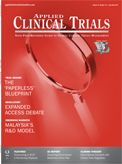Collaboration On EU’s New Clinical Trials Rule Brings Opportunity, Challenges
Applied Clinical Trials
Application review will require closer cooperation between ethics committees and competent authorities in several areas.
A new regulatory framework for the authorization, conduct and supervision of clinical trials across the European Union (EU)/European Economic Area (EEA) was published on May 25, 2014. The regulation is expected to go into effect by October 2018, following confirmation that the IT infrastructure underpinning its implementation (the EU portal and database) is fully functional.
The new Regulation aims to streamline the submissions and authorization procedures for clinical trials by the creation of a single submissions portal and coordinated assessment between EU member states concerned with the trial.
Decisions on a clinical study will be made on a member-state basis, rather than separate competent authority and ethics committee (EC) decisions as is currently the case under Directive 2001/20/EC; however, the Regulation does not dictate how a member state should be organized to reach its decision: “It should be left to the member state concerned to determine the appropriate body or bodies to be involved in the assessment of the application to conduct a clinical trial and to organize the involvement of ethics committees within the timelines for the authorization of that clinical trial as set out in this Regulation.”
The review of an application will involve drafting of a “Part I” and a “Part II” assessment report. Part I will focus mainly on benefit-risk considerations and will be assessed in cooperation with all concerned member states (CMS) with a “reporting member state (RMS)” taking the lead.
Part II will involve only national considerations such as informed consent and suitability of investigators and sites. In most (if not all) member states, ECs will exclusively assess Part II aspects and will have input into the Part I assessment report, with competent authorities taking the lead.
The timelines involved in reaching an assessment conclusion are 45 days for both Part I and Part II assessment. A maximum of an additional 31 days can be added to the overall time frame if the member state needs to obtain further information from the sponsor organization. ECs will need to consider how they will deal with the review of responses from the sponsor, which will be submitted via the EU portal any time up to 12 days following the request for information. This review may also require interaction with the competent authority to reach an agreed member state position.
An additional challenge for ECs arises when their member state is acting as RMS. In these cases, the draft Part I assessment report needs to be circulated to the CMS by day 26, who then have 12 days to provide their considerations. The RMS then has seven days to consolidate these considerations and finalize the assessment report. These time frames raise challenges for ECs involved in the Part 1 assessment. For example, will they be able to meet and review the documentation by day 26? Will they meet again to consolidate the considerations from CMS 12 days later, convene a subgroup, take chairman’s action, or leave it to the competent authority?
The single member state decision on the trial will be submitted to the sponsor via the EU portal within five days of the conclusion of the Part I and/or II assessments (whichever is later).
It is not only the assessment of applications that will require closer cooperation between ECs and competent authorities under the new Regulation. Activities such as validation of the application, declaring willingness to act as RMS, provision of considerations to the RMS (or consolidation of the considerations if your member state has the RMS role), and submission of information to the EU portal are all done on a member-state basis and need to be performed under a defined timeline. In addition, any appeal to a decision for an application will need to be organized on a member-state level rather than being submitted to the individual organizations involved.
These activities present new opportunities and challenges to both competent authorities and ECs, particularly in light of the fact that review of trials of investigational medicinal products (IMPs) may only be a small proportion of an ECs total workload. In the UK, it is estimated that approximately 15% to 20% of research reviewed by ECs is for IMP studies.
In order to meet the requirements of the new Regulation, many member states have needed to reorganize their ECs system. In practice, this has involved reducing the number of committees and the introduction of a form of centralized coordination in the member state. In the UK, this central coordination is carried out by the Health Research Authority (HRA).
Many member states are considering, or have already begun, piloting new ways of working under the Regulation. This is arguably the most efficient way to prepare for the exciting future that lies ahead in order to provide consistent and timely decisions on trials for the benefit of public health.

Martin O’Kane is Head, Clinical Trials Unit, Medicines and Healthcare Products Regulatory Agency (MHRA), UK

Including Women of Childbearing Age in Clinical Research
March 26th 2024In recognition of International Women's Month, we're featuring this recent talk between Associate Editor Miranda Schmalfuhs and Marie Teil, Global Head of UCB’s Women of Childbearing Age Program. They speak about the specific challenges women with chronic illnesses face when accessing appropriate treatment and participating in clinical trials, UCB's Women of Childbearing Age Program and it’s most successful strategies, and much more.
Improving Engagement While Maintaining Data Integrity & Validity
March 19th 2024In recognition of Women's Health Month, we're featuring this recent talk between Associate Editor Miranda Schmalfuhs and uMotif's Chief Product Officer, Julia Lakeland, discuss new technologies improving patient engagement and reducing the emotional and logistical burdens of participation, ethical considerations that should be addressed when implementing those technologies, while ensuring patient privacy, and much more.
Regulatory Compliance With eCOAs
April 26th 2024In the fourth and final part of this video interview with ACT editor Andy Studna, Melissa Mooney, director, eCOA sales engineering, IQVIA discusses how the regulatory stance on electronic clinical outcome assessments has changed over the years and what it could look like in the future.